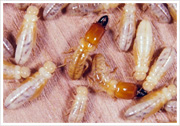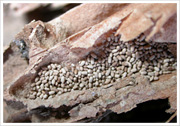 |
 |
| (Source: anic.ento.csiro.au) |
(Source: chem.unep.ch) |
The drywood termites produce mature colonies that consist of only a few thousand individuals. They never live in soil and require no ground contact and do not build mud tubes
Drywood termites form colonies in a similar manner to other termites. They have flying forms, known as alates, which fly out in great numbers from mature colonies at certain times of the year. This process is known as swarming. Alates in a swarm will find mates and then flutter in search of dead wood in which to start a colony. Unlike the subterranean termites, the drywood termites form colonies within the wood itself rather than in the soil below. Since drywood termites form colonies within sound dead wood, they have no access to free water. This is the reason for their common name, drywood termites. Instead, they must either acquire water through metabolism (of wood) or through moisture in their environments. Since these termites live within their food, they must find ways to remove waste from their colonies. Drywood termites make small holes in the wood they infest and occasionally kick out fecal pellets or frass. Piles of the pellets usually accumulate under these openings. These dry, smooth pellets are very characteristic of the presence of drywood termites.
Wood is damaged as the drywood worker termites tunnel to enlarge their colony. Drywood termite galleries cut across the wood's grain thus weakening the wood's internal structure and eventually the wood fails. Fecal pellets may be packed into some of the galleries.
Drywood termite damage tends to progress more slowly than damage from subterranean termites but because it is so difficult to detect, considerable damage, extending over a wide area, may be present by the time it is first found.
Finished wood should then be finished with a paint or wood protection paint. DTM Wood Protectant provides long lasting protection against all wood boring insects. It can be diluted with oil or water & it protects wood products from month to year.
Mechanical removal and replacement - This is the most effective way to solve the infestation. If the infestation is isolated/contained in a small area and the infested wood can be removed and replaced, this should be recommended. The infested wood must be removed from the structure and destroyed. If the infestation is heavy, wooden products need to be disposed.
Injection treatment - Injection using syringe can be done to treat the infested area. Fecal pellets need to be clear before the injections. Proper injection should penetrate into galleries & inaccessible areas to target egg & larvae when the insecticide is absorb by the wood. It must be noted that injections may cause some discoloration to the surface of the wood that is being treated. |


